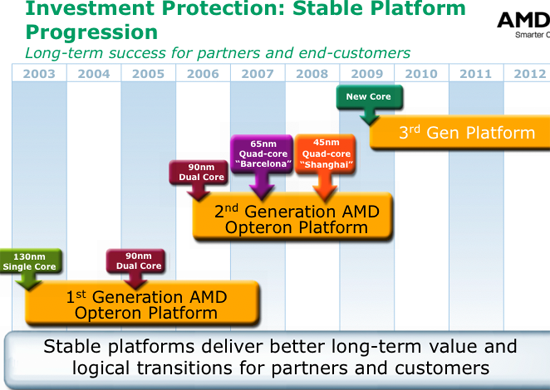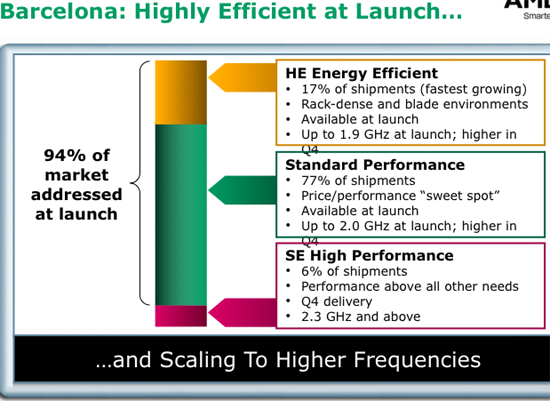It always seems that the worse a company does, the more information it divulges. We saw this behavior with Intel at the end of the Pentium 4 era, and we're definitely seeing it now with AMD. Enjoy it while it lasts, because it sure makes the industry a lot more exciting to talk about.
Today's disclosures are many of the things we alluded to in our last article about AMD's future, what we called The Road Ahead. If you were waiting for us to fill in the blanks, this article will do just that.

Barcelona is the second CPU to plug into what AMD is calling its 2nd generation Opteron platform, it will have one more socket-compatible successor before the platform is retired:

The first Barcelona processors available will be the HE (Energy Efficient) and standard performance CPUs, running at speeds of 2.0GHz or lower at launch:
In Q4 of this year AMD will introduce the SE (High Performance) Barcelona parts, running at 2.3GHz and above.
AMD is doing its best to sugar coat the low clock speed launch by saying that it's addressing the majority of the market at these clocks, but the fact of the matter is that AMD would be singing a different tune if it was able to achieve higher clock speeds at launch.
Today's disclosures are many of the things we alluded to in our last article about AMD's future, what we called The Road Ahead. If you were waiting for us to fill in the blanks, this article will do just that.
Barcelona Update
Before getting into the new stuff, AMD gave us a brief update on Barcelona, whose launch is now hopefully less than a month away.
Barcelona is the second CPU to plug into what AMD is calling its 2nd generation Opteron platform, it will have one more socket-compatible successor before the platform is retired:

The first Barcelona processors available will be the HE (Energy Efficient) and standard performance CPUs, running at speeds of 2.0GHz or lower at launch:
In Q4 of this year AMD will introduce the SE (High Performance) Barcelona parts, running at 2.3GHz and above.
AMD is doing its best to sugar coat the low clock speed launch by saying that it's addressing the majority of the market at these clocks, but the fact of the matter is that AMD would be singing a different tune if it was able to achieve higher clock speeds at launch.










31 Comments
View All Comments
flashbacck - Thursday, July 26, 2007 - link
Whoever decided those acronyms were necessary should be fired.fzkl - Thursday, July 26, 2007 - link
Like mentioned, the obvious great benefit of having low power x86 chips on mobile phones is the software aspect. PC applications can now run on phones reducing aspirin needs for developers. However, what does this mean in terms of security? Can we see mobile phones needing frequent patches, antivirus, firewalls like in the case of desktops?If this were to be the case we would have successfully made a simple device like the mobile phone(in usage terms) a high maintenance product which a layman might have trouble with.
sheh - Thursday, July 26, 2007 - link
x86 doesn't imply any OS or API. Linux, which is commonly used today on all kinds of devices, can work just as well on x86. Conversely, nothing prevents virus writers from writing viruses for Linux running phones.beyoku - Thursday, July 26, 2007 - link
what happened? Was this article recelty pulled off or something?NDA???
Guuts - Thursday, July 26, 2007 - link
Looks to me like he's trying to get the images working...erwos - Thursday, July 26, 2007 - link
Fusion looks like it'll be a fantastic chip for UMPCs and laptops. Hopefully they'll manage to squeeze more than CPU one core on there, too. Bobcat looks similarly fun - x86 phones! VIA was also discussing this idea, and I could really go for it.That said, AMD is really under-delivering with Barcelona - I suspect the next few years will be pretty rough. Intel has set a low ceiling price for the Barcelonas ($270 - same as the Q6600), and that's not going to be good for AMD's margins.
mlau - Thursday, July 26, 2007 - link
Embedded is ruled by ARM, Freescale, mips and sh derivates; amd and intel are going to have a tough time getting a super-ugly system like pc-x86 (with it's
legacy baggages "bios", "acpi" [you know, the stuff windows requires to run], ...) into that space.
Spoelie - Friday, July 27, 2007 - link
you do not need to have those things to run an x86 cpuloot at EFI for example, in use by apple on their x86 based macs = no more bios.
qpwoei - Sunday, July 29, 2007 - link
The real problem with x86 is that it's inherently not power efficient. To get good x86 performance requires lots of transistors and lots of power due to complex decoders and schedulers. A much simpler architecture like ARM requires very few transistors to run efficiently (at the expense of slightly less compact executable code), and is much more suited for battery-powered devices.Not to say that there won't be x86-powered devices in the future, just that I don't expect them to really gain much of a foothold in any place where battery life is important (eg: phones).
ss284 - Thursday, July 26, 2007 - link
Return of the Jedi